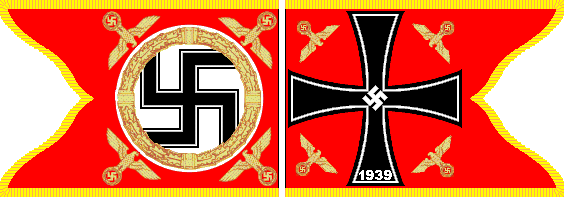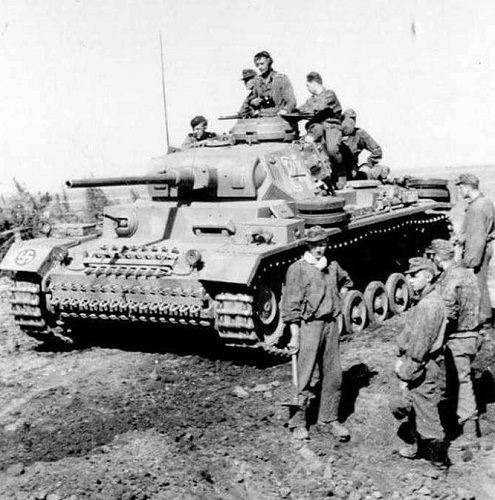At the beginning
of the Russian campaign (22 June 1941) there were
three Waffen-SS motorized
infantry divisions: Das Reich, Totenkopf and Wiking. All
were similar to but larger and better equipped than
the Army’s motorized
infantry divisions.
The elite Liebstandarte SS-Adolf Hitler had
been expanded from regimental to brigade size (and
was classed as a division), having received a fourth
motorized infantry battalion, a motorized
reconnaissance battalion, a composite field
artillery regiment and other units. Additionally, the so-called Kappfgruppe Nord (Battle
Group North) was in the process of being raised;
later it
was redesignated as the 6th SS Mountain Division Nord. Finally
there was the Polizei Infantry Division,
which though it
was administered by the Waffen-SS, remained outside that organization until February
1942.

Standard for
motorized and armored battalions of the Liebstandarte
SS-Adolf Hitler
The Waffen-SS order of battle was rounded out by two motorized infantry
brigades formed with men drafted in from the SS-Totenkopfverbände (SS
Death’s Head Units)—mostly concentration camp
guards. There was also an SS Cavalry Brigade. This
unit was formed in July 1941 using two Totenkopfverbände cavalry
regiments raised in 1939 for “pacification” duties
in occupied Poland. In Russia these
three brigades were employed on rear-area security
duties in the Pripet Marsh area, a mission that
involved them in the commission of numerous
frightful atrocities against civilians and Red Army
POWs. It has been estimated that troops of the SS
Cavalry Brigade killed almost 24,000 Soviet
civilians, many of them Jews, during "anti-partisan"
sweeps in August and September of 1941. The SS
Cavalry Brigade's commander was SS-Standartenführer Hermann
Fegelein, who later (June 1944) married Eva Braun's
sister Gretl.
In addition to these
formations, a number of foreign volunteer units had
been raised and were undergoing training. They were
sponsored by the SS and their personnel wore the SS
uniform, but they were not as yet considered part of
the Waffen-SS. Most of these volunteers came
from the Scandinavian countries, Belgium and the
Netherlands.
The Liebstandarte and
the three motorized divisions were all heavily
engaged in the opening battles of the Russian
campaign, gaining a reputation—somewhat
exaggerated—as elite shock troops. Totenkopf (along
with Polizei)
served in Army Group North; Das Reich served
in Army Group Center; Liebstandarte and Wiking served
in Army Group South. Kappfgruppe Nord served
above the Arctic Circle in the Army of Norway.
Having suffered
heavy casualties and equipment losses from June 1941
through early 1942, the Waffen-SS divisions
were refitted in preparation for the 1942 campaign—Himmler’s
influence ensuring that they received the best
available manpower and material. The Liebstandarte became
a division in fact as well as in name, and as the
senior formation of the Waffen-SS was
exceptionally well provided for. It acquired both a
panzer battalion and a full assault gun battalion,
the former equipped with 20 x Panzer II and 42 x
Panzer IV tanks. The divisional antitank battalion
and the regimental antitank companies received
self-propelled 47mm and 75mm AT guns in large
numbers. Two of the other three divisions also got a
panzer battalion; only Totenkopf
had
no tanks. One infantry battalion of Das
Reich received
armored halftracks in place of trucks.

A Panzer IIIJ
(50mm/L60 gun) of the Wiking Division in Russia, spring
1941 (Bundesarchiv)
Also by 1942 the
foreign legions that had been set up in 1941 were
ready for service and began to appear in the Waffen-SS order
of battle. Some, like the SS-Finnisches
Freiwilliger-Bataillon (SS
Finnish Volunteer Battalion) were incorporated into
the divisions—the Finns serving with Wiking.
Most, however, like the SS-Freiwilliger-Legion
Norwege (SS
Volunteer Legion Norway) were assigned to the two SS
motorized infantry brigades. As the war dragged on
with the need for manpower becoming more and more
acute, many additional foreign formations were
raised by the SS, eventually encompassing most of
Europe’s major ethnic groups.
The 1942
organization of the Waffen-SS motorized
divisions transformed them from motorized infantry
divisions to light mechanized divisions with a
significant number of armored fighting vehicles: an
organizational template for the panzer grenadier
division—as both Waffen-SS and
Army motorized infantry divisions were soon to be
retitled. It was never possible for the Army’s
panzer grenadier divisions to achieve the desired
standard but thanks again to Himmler, their SS
counterparts were more fortunate. Usually they had
both a tank battalion and a company—sometimes a full
battalion—of assault guns, along with a strong
contingent of self-propelled antitank guns. At full
strength they were virtually light armored divisions
but even the Waffen-SS had
trouble replacing the heavy losses its units
suffered on the Eastern Front and later in Western
Europe. And the Army, in competition with the Waffen-SS for
increasingly scarce resources, was the ultimate
loser. The men, weapons and equipment that went to
the Waffen-SS were
a drain on the Army, which could have made far
better use of them in the increasingly desperate
struggle to stave off a greatly superior enemy
coalition.